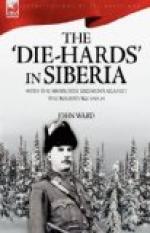The influence of the Koltchak Government could be seen in the orderly management of affairs connected with the railway and supplies generally. Not till we reached Kameragh could we observe any sign that there still remained unextinguished embers of the social inferno through which the country had passed. At this point the line was guarded by a strong detachment of troops quartered in trucks on the siding. The officer in command informed me that an attack by revolters had been made on the line at this point, who had held up the traffic for some hours, but had been driven off before any permanent injury was accomplished. The revolters did not wait after the attack, but set fire to the station and departed. He suggested that it might be as well to be ready for sniping, and for worse things, should accident force the train to come to a standstill between here and Krasnoyarsk. We arrived at the latter place, however, without incident on February 25.
Krasnoyarsk is a fairly large town on the River Yenesei. The fine bridge over the river is the point to which the eyes of the revolters are constantly directed. The garrison was composed of one company of the 25th Middlesex Regiment, an Italian battalion recently formed from amongst the Italian prisoners of war and armed by the British, about four hundred Cossacks, and a company of Czechs belonging to the 10th Regiment, who arrived that morning. There were numbers of Bolsheviks inhabiting an elevated part of the town. These met on the old Russian New Year’s Day and passed a resolution that it was necessary to execute all army officers wherever they might be found isolated from their comrades. The army chiefs replied by ordering all guns to be trained on the Bolshevik part of the town and one round of shell from each of the eight guns to be planted in the Bolshevik quarters for every officer murdered. No officers had been murdered up to that time. A party of Serbians who had been armed to assist in protecting the inhabitants were caught selling arms and ammunition to the Bolsheviks; they were surrounded in the middle of the night and disarmed, one Cossack being killed. The 25th were “standing to” during this operation in case their assistance was required.
We started for Irkutsk on the 25th, having been warned that the road to Kansk was practically dominated by the revolters. About 8 P.M. we arrived at the headquarters of General Affinasiaff, who came into my car and gave a minute description of the situation. The enemy forces numbered about 8,000, and those of the Russian Government about 3,000. For about one hundred versts the Russian forces, in small detachments, were allowing themselves to be pinned to the railway.
It was very interesting to hear a clear statement as to the cause of the revolt and to find that the chief point of the grievances set forth in the revolters’ own proclamations. In great part these opponents of the Government consist of rich peasants, who already possessing land which in many cases was equal in extent to the County of Rutland, had in 1917, under the order of Lenin and Trotsky, taken forcible possession of the furniture, horses, farmhouses, carts, carriages, land, etc., of the big landholders, who with their families had been massacred by these same rich peasants.




